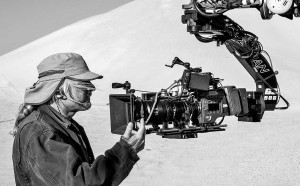
With an Oscar for best cinematography on Life of Pi, Claudio Miranda’s career elevated to the heights of a select group of directors of photography highly in-demand on the biggest new film projects. Right on the heels of Life of Pi, Miranda faced another challenge with the futuristic sci-fi film Oblivion, which places Tom Cruise on an earth destroyed by an alien power. In this exclusive interview, Miranda discusses his choices for lighting and shooting Oblivion, many of which will surely surprise viewers in its execution, with front projection screens being utilized in lieu of blue or greenscreens in back of its sets, all created on stage in Baton Rouge, Louisiana.
Below the Line: What was the biggest development for you with Oblivion, especially coming straight off of Life of Pi?
Claudio Miranda: We wanted to do a little more in camera than we did on Life of Pi. We used this projection system, which was the biggest unique aspect about the whole movie. I was playing with some media panels on Tron. I just loved the idea of doing it that way. [For Oblivion], we did front projection. The screen was massive – 21 projectors for 500 feet. Even the actors loved to be at it: a 270-degree view that we covered. I sent a crew to one of the mountains on the main island of Hawaii at one of the volcanoes. They got 15K plates on the top of the mountain. It was running at three times speed.
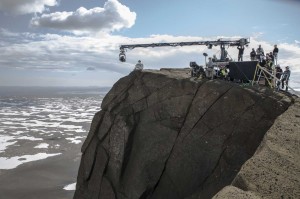
BTL: How did you ensure that the images from Hawaii would perfectly serve as a background to your sets?
Miranda: These projectors are made to be integrated between each other. The lead media server bled all of the projectors into one. They have blending capabilities; they are meant to blend together for trade shows, spreading across horizontally. They were never done to this scale with 15K content playing across it. [Tom Cruise] was lit by the bounce off of the projectors. I lit Tom mainly with projections and a little bit of bounce here and there. It really lights the room up.
BTL: Why did you choose this method where most DPs would have shot their sets against a blue or greenscreen?
Miranda: You are in a real environment and make real choices. Bluescreen would have been a disaster. The set design had glass and chrome. If we turned it blue [and] the set disappears, you get VFX recreating the set. There is a shot where Tom is going from inside to outside. You totally buy it – it’s all in-camera. When you are in editorial, all of these shots are real, not bluescreen comps. Normally, we would have had 1,500 VFX shots, but we cut it down to 800.
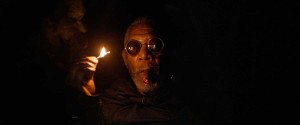
BTL: Why did you choose to shoot with a digital camera as opposed to shooting on film?
Miranda: It was the sharpest tool in the shed. We used the F65. It goes off to cards – little proprietary cards. That goes to the lab and we do lab color correction. [Director] Joe Kosinski is going after a 4K release for the movie. We did Tron with the F35. I like the shutter. We were showing Iceland in its full detail. Iceland is a place that has black volcanic ground with detail and overcast skies – and you want detail in there. You want a camera with huge dynamic range to show detail in both.
BTL: The non-location sets in this movie have a life of their own. How were they created?
Miranda: None of the sets could be built to the ceiling — it holds no weight. They were glorified rain covers. All it could do was hold the screen. Even the whole glass set and the library set, a massive set – all of that is supported from the floor. On a normal stage like in Los Angeles, you’d support from the ceiling. The library set was a massive build. We have light beaming down. As he goes deeper in the world, that flashlight is doing 90% of the work; light would be re-reflected back onto his face.
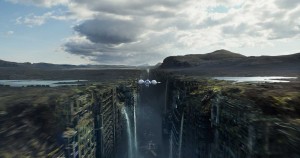
BTL: Additionally, your use of locations gives the movie a unique look in the world of post-apocalyptic films. Why did you shoot location after stage work?
Miranda: A lot of it had to do with weather. We shot in Iceland. It was logistical— it would have been covered in snow [if we shot there before we shot on stage]. One shot of Cruise is on the edge of a cliff – that is only accessible by helicopter. All of the technocranes had to be flown on top. It was an amazing place. Little ideas grow. We were going to be really simple, handheld, then a jib, then a technocrane, then we got two cranes. A little idea escalated into a massive idea. The helicopter support was pretty amazing.
BTL: Between your stage work with projection screens and location work in Iceland, were all of the film’s visual effects added to your live-action footage?
Miranda: If you are in the glass house, that is all in-camera. If you are in Iceland, it’s mostly real too. There are VFX shots inserted into this landscape. The library is all in-camera. They built that bubble ship. The screen had to go around that ship 75 feet to the wall just to encapsulate that. The ship made it massive. We really tried to capture the plates of Tom riding his motorcycle on the ground. Digital Domain and Pixomondo did a great job of adding visual effects – the Capitol Building and the Washington Monument were aerial shots that they integrated.
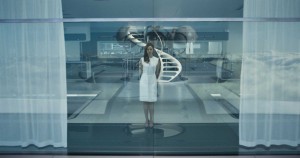 BTL: How do you see your role integrated with the visual effects supervisor, production designer and director of a film?
BTL: How do you see your role integrated with the visual effects supervisor, production designer and director of a film?
Miranda: I think a director should be in charge of the image you are getting. It’s important for myself to be a collaborator with production design and VFX to meld our look. Joe and I have been talking about this job since Tron, the natural light of this place and the technique in shooting it. I always like things to feel very natural in the things we shoot. In Oblivion there are scenes that we love to reach for – there is just a candle in the middle of the table lighting the whole room plus projections lighting the scene. You see Tom flickering. There is no faux lighting in there at all. Joe and I both respond to that. How to make it feel real? The control tower, which we lit also via projection — you light that and there’s a sky out there – to watch the actor’s face be lit by that, it feels real. It’s a new way of lighting. I seem to get movies that are somewhat challenged. Life of Pi was the same way. In itself, it had to be lit very naturally. I lit it to those samples of skies that we had and visually extended it later on. The team of three, it was definitely myself and VFX working together and making the environment fit. You have to be in sync.
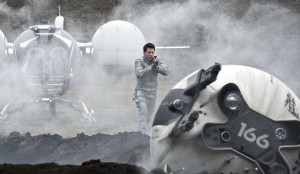
BTL: This movie seems like a progression for you from Life of Pi in terms of integrating these techniques with which you are experimenting.
Miranda: This movie is pretty stunning too. In the trailer, Morgan Freeman is very dark. It looks like VFX even thought it’s not. I used Tom as a bounce card for Morgan. It was great because Morgan was wearing these glasses. Tom set right next to the camera. I gave Morgan Freeman barely any light. Reality looks fake. Even on Life of Pi, people picked out real tigers and said that they were fake.
BTL: Is it true that you enjoy gravitating to difficult projects? Tomorrowland, your next film, seems like it’s going to be another huge project.
Miranda: If I see a movie that has something interesting that we can do, I get very excited about it. I loved the task of figuring out this Oblivion projection system. You see the results of what it is. Tomorrowland has some things that we are testing. There are some really cool things that have not been seen before. I get excited about these little puzzles. Sometimes, I do commercials and get involved in simpler set-ups. I get attracted to directors who have something to say. Joe Kosinski has an architecture background and my dad is an architect. I have a lot of background with David Fincher; we have a common end goal. It’s nice to work with those kinds of people.





